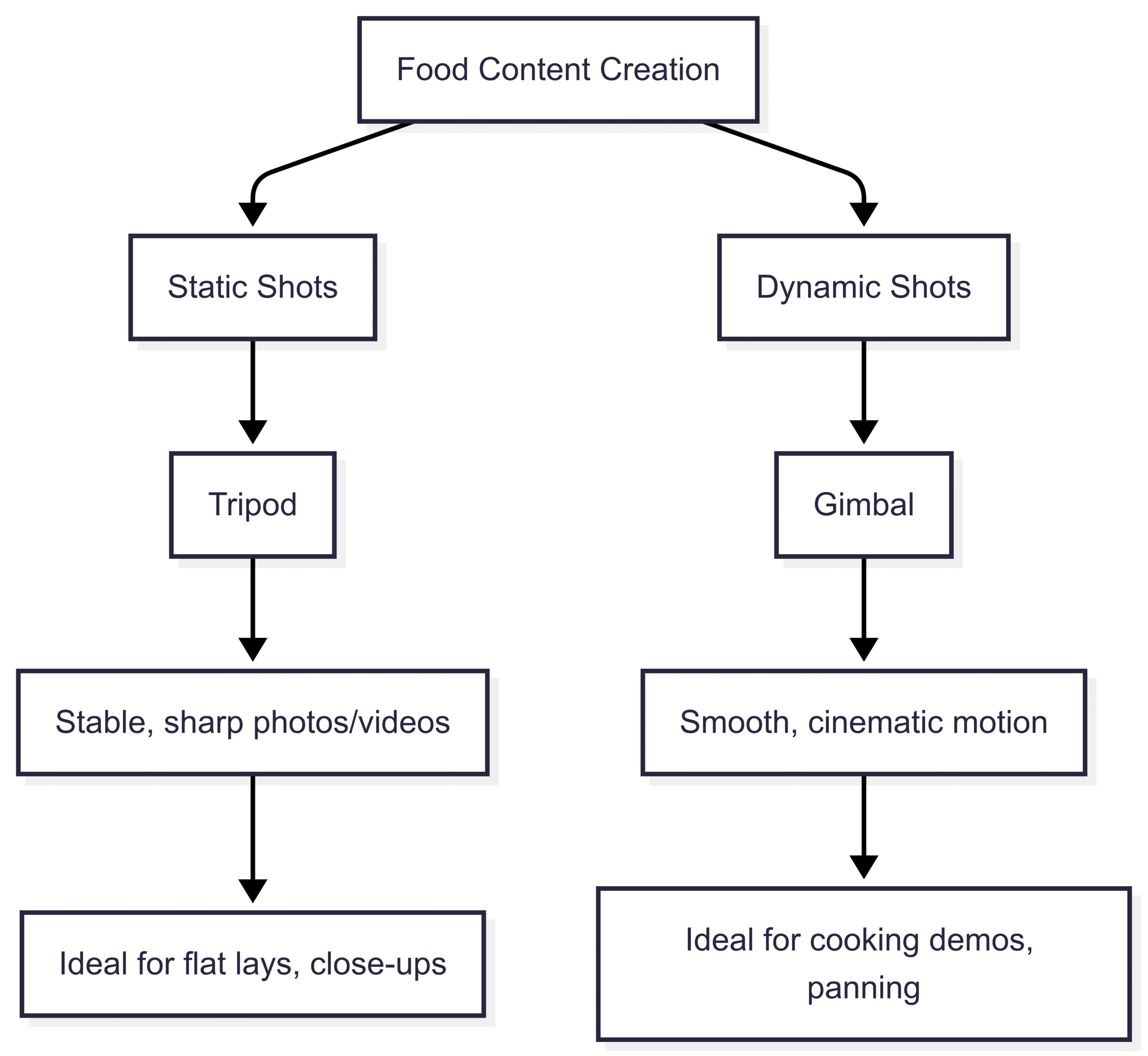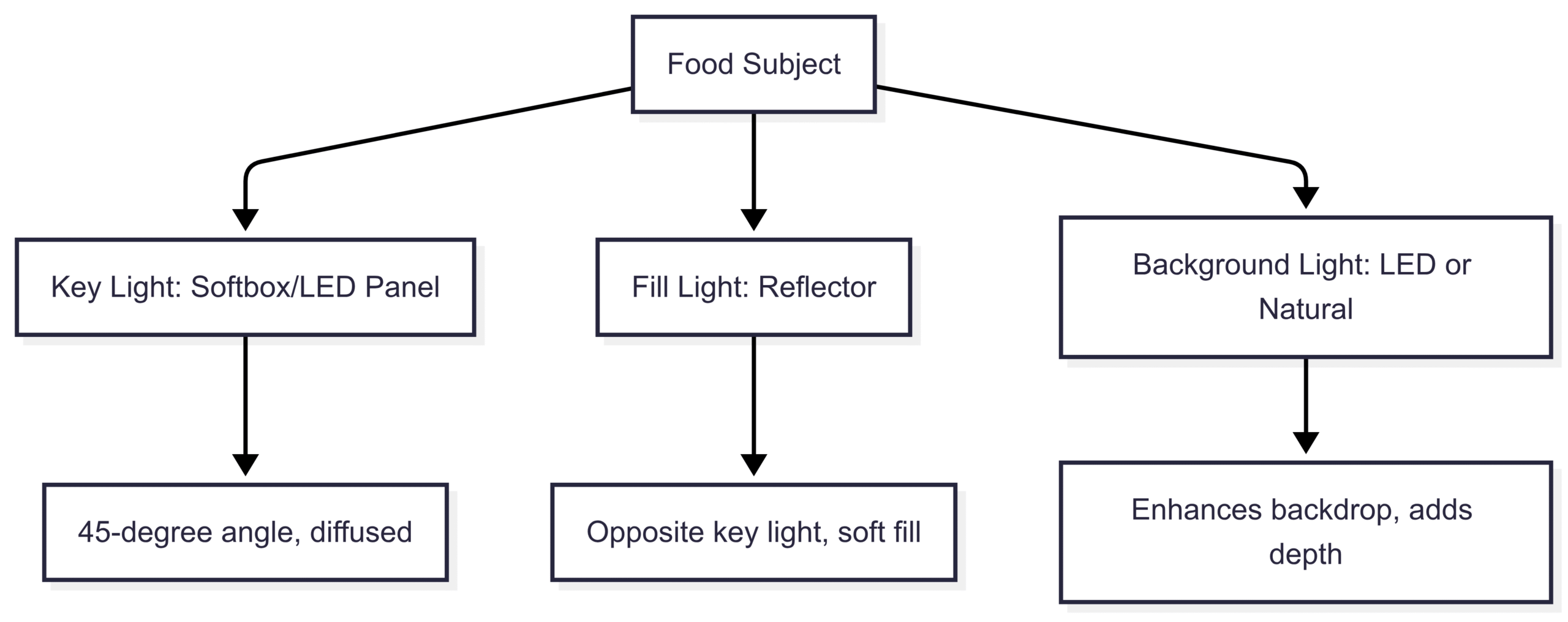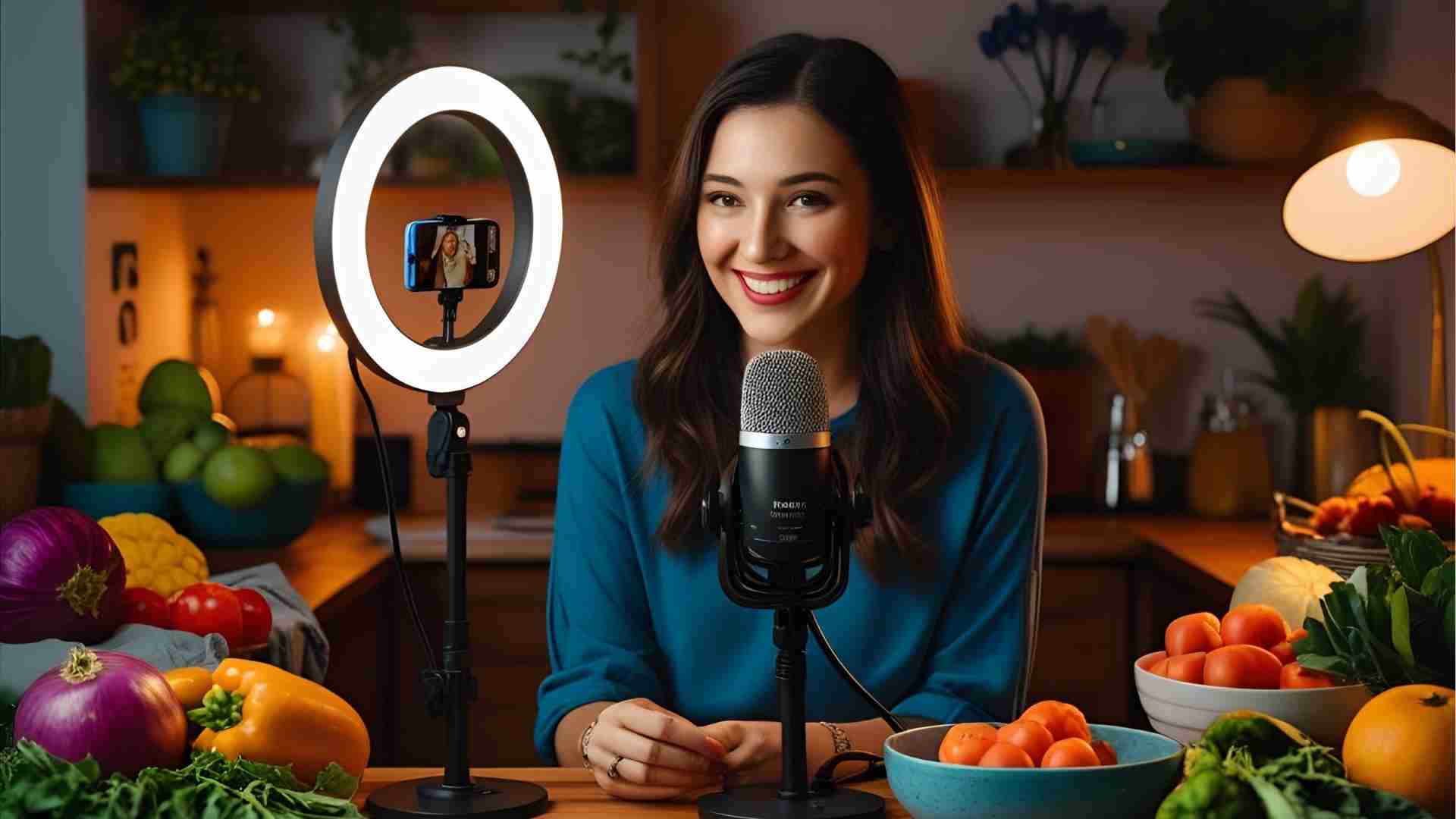Food Content Creator Equipment You Need
Discover essential food content creator equipment: cameras, lighting, tripods, and more to elevate your food photography and videography.
Creating captivating food content is an art that blends culinary creativity with technical precision. Whether you’re a food blogger, a YouTube chef, or an Instagram influencer, the right equipment can transform your dishes into visually stunning masterpieces that engage and inspire your audience. This comprehensive guide explores the essential gear every food content creator needs, from cameras and lenses to lighting, audio, and post-production tools. We’ll also cover supporting accessories, cooking equipment, and strategies for content management and continuous learning to help you succeed in the competitive world of food content creation.
Why the Right Equipment Matters
High-quality food content isn’t just about the recipe—it’s about presenting your culinary creations in a way that makes viewers hungry. The right equipment ensures your photos and videos capture the vibrant colors, textures, and details of your dishes. A professional setup can elevate your content, making it stand out in a crowded digital space. From choosing the perfect camera to mastering lighting, every piece of gear plays a critical role in delivering mouth-watering visuals and engaging storytelling.
Essential Equipment for Food Content Creation
To create professional-grade food content, you need a well-rounded toolkit. Below, we break down the core equipment categories every food content creator should consider.
1. Cameras and Lenses
The camera is the cornerstone of your food content creation setup. It determines the clarity, color accuracy, and overall quality of your photos and videos.
Camera Options
- Smartphones: For beginners or those focused on social media platforms like Instagram and TikTok, a high-quality smartphone camera is a cost-effective starting point. Modern smartphones, such as the iPhone 14 Pro or Samsung Galaxy S23 Ultra, offer 4K video recording, excellent low-light performance, and built-in stabilization. These are ideal for quick setups and portable shooting.
-
DSLRs and Mirrorless Cameras: For creators aiming for professional-grade content, DSLR or mirrorless cameras provide superior control and image quality. Popular models include:
- Canon EOS R6: Known for excellent low-light performance and 4K video capabilities. Price: ~$2,499 (body only).
- Sony A7 IV: Offers superb color reproduction and versatility for both photo and video. Price: ~$2,499 (body only).
- Nikon Z6 II: A great balance of performance and affordability. Price: ~$1,999 (body only).
Key Considerations:
- Look for cameras with high-resolution sensors (20MP or higher) for sharp images.
- Ensure 4K video recording for crisp, modern content.
- Check compatibility with external microphones and accessories.
Lenses
Lenses are just as crucial as the camera body. They determine how your food is framed and how the background appears.
- Prime Lenses: A 35mm or 50mm prime lens with a wide aperture (f/1.8 or f/1.4) is ideal for food photography. These lenses create a shallow depth of field, blurring the background to emphasize the dish. Example: Canon RF 50mm f/1.8 STM (~$199).
- Macro Lenses: Perfect for capturing fine details like the texture of a crusty loaf or the glaze on a dessert. Example: Sony FE 90mm f/2.8 Macro G OSS (~$1,098).
- Zoom Lenses: Offer flexibility for varied compositions, such as wide shots of a tablescape. Example: Nikon AF-S 24-70mm f/2.8E ED VR (~$2,099).
Pro Tip: A wide aperture (low f-number) enhances the aesthetic appeal by creating a creamy bokeh effect, making your food the star of the shot.
Camera Comparison Table
| Camera Model | Resolution | Video Capability | Low-Light Performance | Price (Body Only) |
|---|---|---|---|---|
| Canon EOS R6 | 20.1MP | 4K 60fps | Excellent | ~$2,499 |
| Sony A7 IV | 33MP | 4K 60fps | Outstanding | ~$2,499 |
| Nikon Z6 II | 24.5MP | 4K 60fps | Very Good | ~$1,999 |
| iPhone 14 Pro | 48MP | 4K 60fps | Good | ~$999 |
2. Tripods and Stabilizers
Stability is non-negotiable for professional-looking food content. Shaky footage or blurry photos can detract from the viewer’s experience.
Tripods
A sturdy tripod ensures sharp, steady shots for both photography and videography.
-
Key Features:
- Adjustable height and angles for versatile compositions.
- Durable materials like aluminum or carbon fiber for stability.
- Compact designs for easy storage and portability.
-
Recommended Models:
- Manfrotto Befree Advanced: Lightweight, adjustable, and ideal for food photography. Price: ~$189.
- Arkon 11″ Adjustable Tripod Mount with Phone Holder: Perfect for smartphone users and small setups. Price: ~$39.95.
Stabilizers and Gimbals
For dynamic shots, such as panning over a dish or filming a cooking process, gimbals provide smooth, cinematic movement.
-
Recommended Models:
- DJI Ronin-SC: A compact gimbal for mirrorless cameras. Price: ~$439.
- Zhiyun Weebill-S: Lightweight and versatile for both cameras and smartphones. Price: ~$349.
Chart: Tripod vs. Gimbal Workflow

3. Lighting Gear
Lighting can make or break your food content. It highlights textures, enhances colors, and sets the mood.
Natural Light
- Setup: Use a large window with diffused light (e.g., through a sheer curtain or white sheet) for soft, natural illumination.
- Cost: Minimal (cost of a diffuser sheet: ~$10-$20).
Artificial Light
- Softboxes: Create soft, even lighting to eliminate harsh shadows. Example: Neewer 2-Piece Softbox Kit. Price: ~$99.
- LED Panels: Adjustable brightness and color temperature for versatility. Example: GVM 800D-RGB LED Panel. Price: ~$159.
- Ring Lights: Ideal for even lighting and vibrant colors. Example: Arkon Rechargeable Clip-On LED Ring Light. Price: ~$29.95.
Light Modifiers
- Reflectors: Bounce light to fill shadows. Example: Neewer 5-in-1 Reflector. Price: ~$29.
- Diffusers: Soften light for a natural look. Often included with softbox kits.
Pro Tip: Experiment with lighting angles (e.g., 45-degree side lighting) to enhance food textures without creating harsh shadows.
Lighting Setup Diagram

4. Audio Recording Devices
Clear audio is critical for engaging food content, especially for tutorials, voiceovers, or cooking demonstrations.
Microphone Types
- Lavalier Microphones: Clip-on mics for hands-free recording. Example: Rode SmartLav+. Price: ~$79.
- Shotgun Microphones: Directional mics to capture focused audio. Example: Rode VideoMic Pro+. Price: ~$299.
- Portable Recorders: For standalone audio capture. Example: Zoom H1n. Price: ~$119.
Key Considerations:
- Ensure compatibility with your camera or smartphone.
- Use windshields or pop filters to reduce background noise.
- Test audio levels to avoid distortion.
5. Storage Solutions
High-resolution photos and 4K videos generate large files, making reliable storage essential.
External Hard Drives
-
Recommended Models:
- Samsung T7 Portable SSD: Fast read/write speeds, 2TB capacity. Price: ~$249.
- WD My Passport: Reliable, up to 5TB capacity. Price: ~$149.
Cloud Storage
- Services: Google Drive, Dropbox, or pCloud offer secure, remote access. Price: ~$10/month for 1TB.
- Benefits: Protects against data loss and enables access from multiple devices.
6. Supporting Accessories
Accessories enhance the functionality and aesthetic of your food content.
Reflectors and Diffusers
- Purpose: Control light to reduce shadows and glare.
- Example: A 32” 5-in-1 reflector kit (~$29) provides multiple color options for different effects.
Backdrops
- Materials: Wood, marble, vinyl, or fabric.
- Example: Kate 5x7ft Vinyl Backdrop. Price: ~$39.
- Tip: Choose neutral or textured backdrops to complement your food without overpowering it.
Props and Styling Tools
- Props: Plates, cutlery, napkins, and herbs to enhance storytelling.
- Styling Tools: Tweezers, brushes, and spray bottles for precise food presentation.
- Tip: Keep props minimal to avoid distracting from the dish.
Camera Mounts
- Example: Arkon Remarkable Creator™ Pro Mount. Price: ~$49.95. Ideal for stable smartphone or camera positioning on flat surfaces.
7. Cooking and Preparation Equipment
Your kitchen tools should be both functional and visually appealing to enhance your content.
Cookware and Utensils
- Pots and Pans: Stainless steel or cast iron for durability and aesthetics. Example: Le Creuset Cast Iron Skillet. Price: ~$199.
- Utensils: Silicone or wooden spatulas, tongs, and whisks to avoid scratches.
Food Processors and Blenders
- Food Processor: Cuisinart 14-Cup Food Processor. Price: ~$249. Ideal for chopping, mixing, and dough prep.
- Blender: Vitamix Explorian E310. Price: ~$349. Perfect for smoothies, soups, and purees.
Cutting Tools
- Chef’s Knife: Wüsthof Classic 8” Chef’s Knife. Price: ~$150.
- Cutting Board: Bamboo or hardwood for durability and aesthetics. Price: ~$29.
Measuring Devices
- Digital Scale: OXO Good Grips Food Scale. Price: ~$55.
- Measuring Cups/Spoons: Stainless steel for precision. Price: ~$19.
8. Post-Production Software and Apps
Editing transforms raw footage into polished content.
Image Editing
- Adobe Photoshop: Industry-standard for photo editing. Price: ~$20.99/month (Creative Cloud).
- GIMP: Free alternative with robust features.
- Canva: User-friendly for social media graphics. Price: Free or ~$14.99/month (Pro).
Video Editing
- Adobe Premiere Pro: Professional-grade editing. Price: ~$20.99/month.
- iMovie: Free for Mac users, ideal for beginners.
- Final Cut Pro: Advanced features for Mac. Price: ~$299 (one-time).
Sound Editing
- Audacity: Free, versatile audio editing.
- Adobe Audition: Advanced noise reduction and multi-track editing. Price: ~$20.99/month.
9. Workstation Setup
A well-organized workstation streamlines your workflow.
Computer and Monitors
- Computer: A powerful PC or Mac with at least 16GB RAM and a fast processor (e.g., Intel Core i7 or Apple M2).
- Monitors: Dual 27” 4K monitors for efficient editing. Example: Dell UltraSharp U2723QE. Price: ~$599.
SD Card Readers
- Example: SanDisk ImageMate PRO USB-C Reader. Price: ~$49. Supports fast transfers for SD and microSD cards.
10. Content Management and Scheduling
Staying organized ensures consistent content delivery.
Content Planning Tools
- Asana: Task management and content calendars. Price: Free or ~$10.99/month (Premium).
- Trello: Visual task organization. Price: Free or ~$5/month (Standard).
Social Media Management
- Buffer: Schedule posts across platforms. Price: Free or ~$6/month per channel.
- Hootsuite: Advanced scheduling and analytics. Price: ~$19/month.
11. Continuous Learning Resources
To stay competitive, invest in ongoing education.
Online Courses
- Skillshare: Courses on food photography and editing. Price: ~$15/month.
- Udemy: Affordable, topic-specific courses. Price: ~$10-$100 per course.
Books
- “Plate to Pixel” by Helene Dujardin: In-depth guide to food photography. Price: ~$24.
Webinars and Conferences
- Attend webinars on platforms like CreativeLive or food-focused conferences for networking and inspiration.
Frequently Asked Questions
What are the essential pieces of equipment for a food content creator?
A camera (smartphone or DSLR/mirrorless), tripod, lighting (softbox or LED panel), and microphone are must-haves. Backdrops and props enhance aesthetics.
Which camera is best for filming cooking videos on a budget?
The Canon EOS M50 Mark II ($699) or a high-end smartphone like the iPhone 14 Pro ($999) are excellent budget-friendly options.
How can food content creators monetize their content?
Monetization options include YouTube ad revenue, sponsorships, affiliate marketing, and selling digital products like eBooks or online courses.
What should I consider when choosing equipment?
Evaluate your budget, shooting environment, and content style. Prioritize lightweight, durable, and compatible gear.
Conclusion
Creating stunning food content requires a thoughtful combination of equipment, from cameras and lighting to audio and editing tools. By investing in high-quality gear and continuously honing your skills, you can produce professional, engaging content that captivates your audience. Whether you’re just starting with a smartphone or building a professional studio, this guide equips you with the knowledge to choose the right tools and elevate your food content creation game.
Please share these Food Content Creator Equipment You Need with your friends and do a comment below about your feedback.
We will meet you on next article.
Until you can read, Why are Food Blog Posts so Long?






